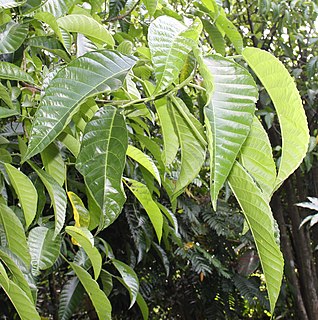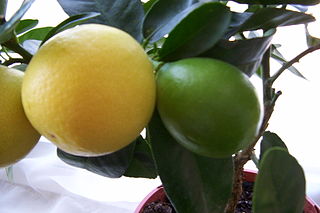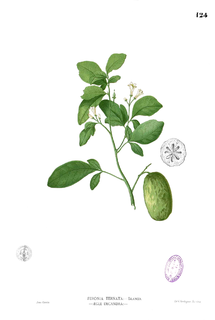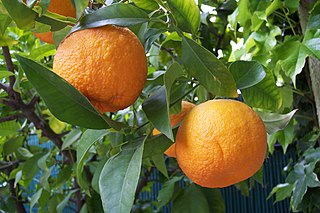
Melicope is a genus of about 240 species of shrubs and trees in the family Rutaceae, occurring from the Hawaiian Islands across the Pacific Ocean to tropical Asia, Australia and New Zealand. Plants in the genus Melicope have simple or trifoliate leaves arranged in opposite pairs, flowers arranged in panicles, with four sepals, four petals and four or eight stamens and fruit composed of up to four follicles.

Dendrocnide is a genus of approximately 40 species of plants in the nettle family Urticaceae. They have a wide distribution across North East India, Southeast Asia, Australia and the Pacific Islands. In Australia they are commonly known as stinging trees.

Walter Tennyson Swingle was an American agricultural botanist who contributed greatly to the classification and taxonomy of citrus.

Dillenia is a genus of flowering plants in the family Dilleniaceae, native to tropical and subtropical regions of southern Asia, Australasia, and the Indian Ocean islands.

Tetrastigma is a genus of plants in the grape family, Vitaceae. The plants are lianas that climb with tendrils and have palmately compound leaves. Plants are dioecious, with separate male and female plants; female flowers are characterized by their four-lobed stigmas. The species are found in subtropical and tropical regions of Asia, Malaysia, and Australia, where they grow in primary rainforest, gallery forest and monsoon forest and moister woodland. Species of this genus are notable as being the sole hosts of parasitic plants in the family Rafflesiaceae, one of which, Rafflesia arnoldii, produces the largest single flower in the world. Tetrastigma is the donor species for horizontal gene transfer to Sapria and Rafflesia due to multiple gene theft events.

Leea is a genus of plants that are distributed throughout Northern and eastern Australia, New Guinea, South and Southeast Asia and parts of Africa. The APG IV system places Leea in the subfamily Leeoideae (Vitaceae). Leea is now placed in the family Vitaceae having previously been placed in its own family, Leeaceae, based on morphological differences between it and other Vitaceae genera. These differences include ovule number per locule, carpel number, and the absence or presence of a staminoidal tube and floral disc. Pollen structure has also been examined for taxonomic demarcation, though studies have concluded that the pollen of Leeaceae and Vitaceae suggests the families should remain separate while other studies conclude that Leea should be included in Vitaceae.

Helicia is a genus of 110 species of trees and shrubs, constituting part of the plant family Proteaceae. They grow naturally in rainforests throughout tropical South and Southeast Asia, including India, Sri Lanka, Indochina, Peninsular Malaysia to New Guinea and as far south as New South Wales.

Pseuduvaria is a genus of the plant family Annonaceae and tribe Miliuseae: with a native range is Tropical Asia.

Aurantioideae is the subfamily within the rue and citrus family (Rutaceae) that contains the citrus. The subfamily's center of diversity is in the monsoon region of eastern Australasia, extending west through South Asia into Africa, and eastwards into Polynesia.

Citreae is one of the two tribes of the flowering plant family Rutaceae, subfamily Aurantioideae, the other being Clauseneae.

Whitfordiodendron is a genus of flowering plants in the legume family, of Fabaceae. It belongs to the subfamily Faboideae.
Adelmeria is a genus of perennial herbs in the family Zingiberaceae which are endemic to the Philippines. Previoulsy, Adelmeria had been considered a synonym of the genus Alpinia, however, after a study showed Alpina to be highly polyphyletic, it was determined in 2019 that Adelmeria was a distinct genus.

Swinglea is a monotypic genus of flowering plants belonging to the family Rutaceae. It only contains a single species, Swinglea glutinosa.
Loheria is a genus of flowering plants belonging to the family Primulaceae.
Beccarianthus is a genus of flowering plants belonging to the family Melastomataceae.
Dalrympelea is a genus of flowering plants belonging to the family Staphyleaceae.
Irlbachia is a genus of flowering plants belonging to the family Gentianaceae.
Koordersiodendron is a monotypic genus of flowering plants belonging to the family Anacardiaceae. It only contains one known species, Koordersiodendron pinnatum(Blanco) Merr.
Merrittia is a monotypic genus of flowering plants belonging to the family Asteraceae. The only species is Merrittia benguetensisMerr.











